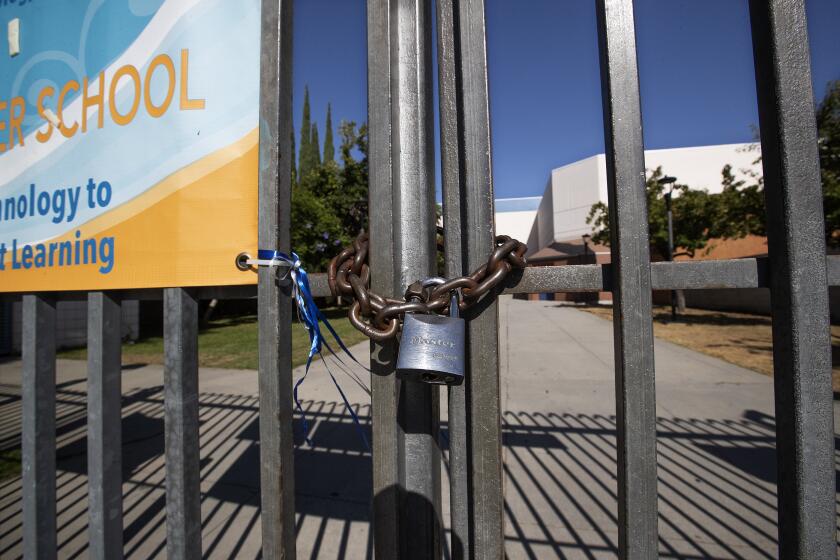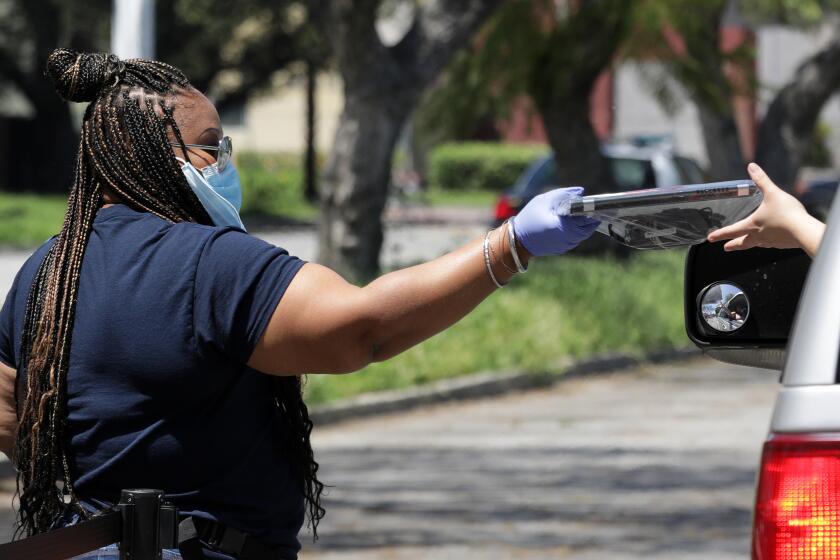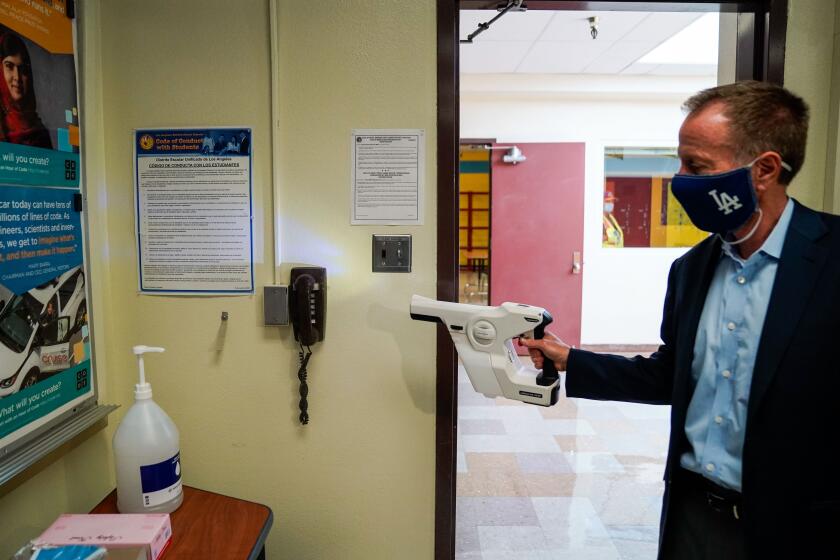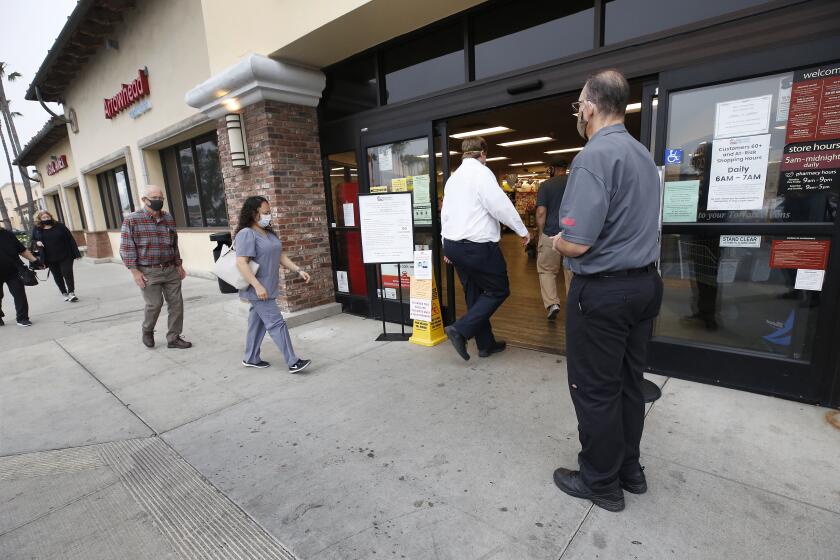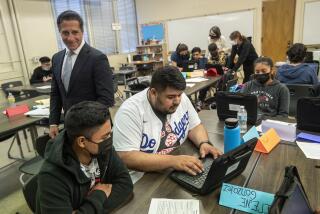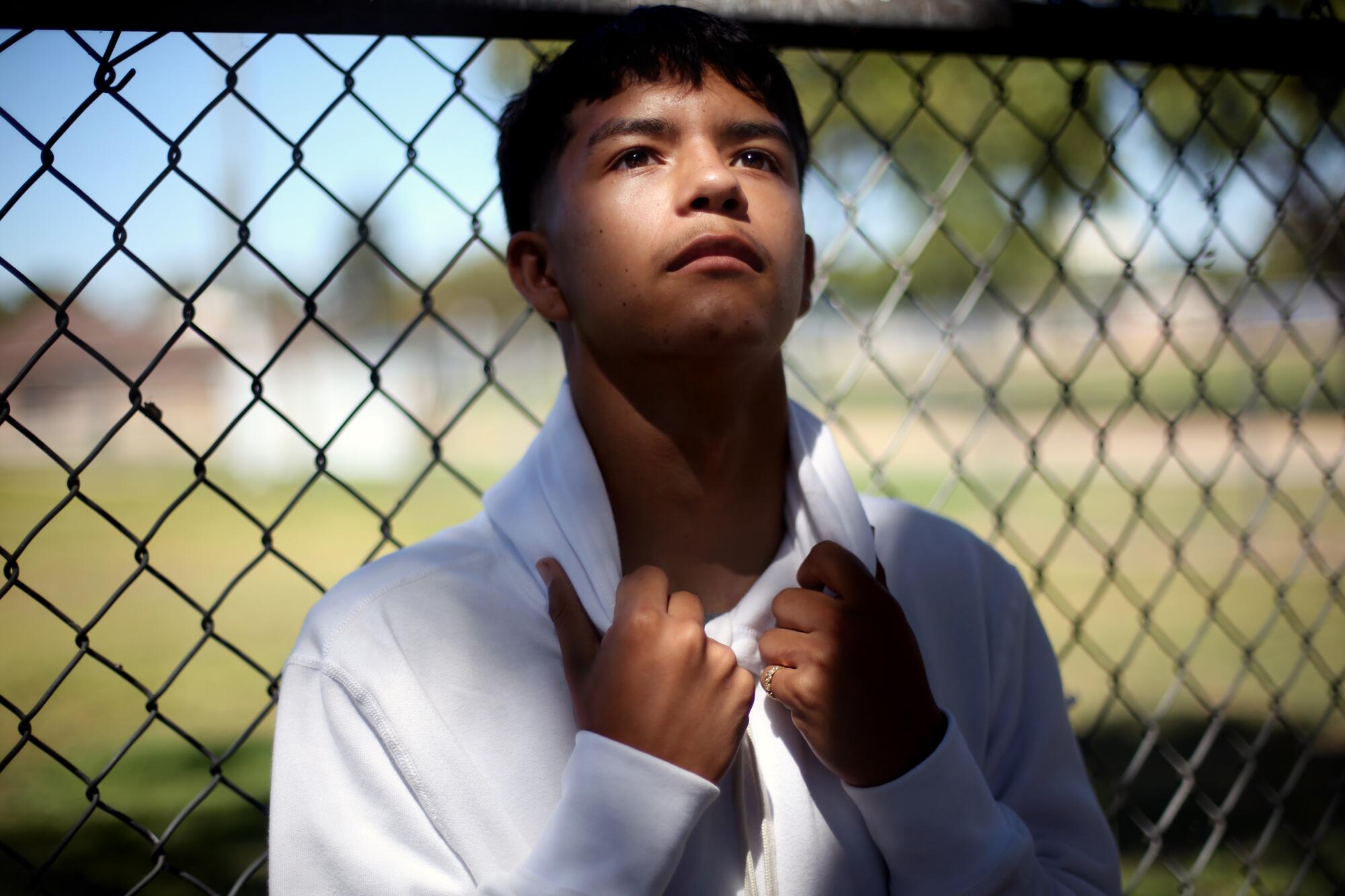
- Share via
Maria Viego and Cooper Glynn were thriving at their elementary schools. Maria, 10, adored the special certificates she earned volunteering to read to second-graders. Cooper, 9, loved being with his friends and how his teacher incorporated the video game Minecraft into lessons.
But when their campuses shut down amid the COVID-19 pandemic, their experiences diverged dramatically.
Maria is a student in the Coachella Valley Unified School District, where 90% of the children are from low-income families. She didn’t have a computer, so she and her mother tried using a cellphone to access her online class, but the connection kept dropping, and they gave up after a week. She did worksheets until June, when she at last received a computer, but struggled to understand the work. Now, as school starts again online, she has told her mother she’s frustrated and worried.
“She says she feels like she’s going to stay behind,” said her mother, Felicia Gonzalez, who has been battling COVID-19.
Cooper, who attends school in the Las Virgenes Unified School District, where just 12% of students are from low-income families, had a district-issued computer and good internet access at home. His school shut down on a Friday, and by the following Wednesday it was up and running virtually. There were agendas and assignments online and Google hangouts with teachers, said his mother, Megan Glynn. While Cooper would prefer to be back on campus, Glynn believes that he and his siblings will be fine academically even with school continuing online.
“I feel fully confident in the education they’ll receive,” she said.
The contrasting realities of these two students reflect the educational inequities that children have experienced since schools closed — and that many will continue to face in the fall as distance learning resumes for 97% of the state’s public school students.
A Los Angeles Times survey of 45 Southern California school districts found profound differences in distance learning among children attending school districts in high-poverty communities, like Maria’s in Coachella Valley, and those in more affluent ones, like Cooper’s in Las Virgenes, which serves Calabasas and nearby areas.
These inequities threaten to exacerbate wide and persistent disparities in public education that shortchange students of color and those from low-income families, resulting in potentially lasting harm to a generation of children.
“The longer this goes on, the longer the pendulum swings to where this could be a generation that’s really left behind,” said Beth Tarasawa, who studies educational equity issues at the not-for-profit educational research group NWEA.
The Times survey found that districts serving communities with the lowest incomes — all with a majority of Latino students — had to confront a wide digital divide when campuses closed in mid-March and struggled for weeks, some more than a month, just to begin online learning. They scrambled to buy computers and hot spots, even as the onslaught of demand led to long delays.
California’s students still need more than a million computers and hot spots, state officials say.
Meanwhile, many districts serving more affluent communities launched their online classes almost immediately, in part because their students had computers and internet access.
Few districts tracked student participation, but among those that did, districts serving communities with the lowest incomes also reported lower student participation than districts in higher-income areas.
The Times surveyed 45 public school districts across Southern California, with a combined enrollment of more than 1.45 million students, and interviewed the leaders in all but a few. The survey included districts that serve both ends of the region’s economic divide: districts serving students from low-income families and those serving children from more affluent communities.
It also included some of the region’s largest districts — such as Los Angeles, San Diego, Long Beach and San Bernardino. On average among the large districts, about 70% of students are low-income, and more than two-thirds are Latino.
The survey defined low-income and more affluent districts by the percentage of students who qualify for free and reduced-price meals. Respondents included 21 districts with the smallest percentage of students who qualify for free and reduced-price lunch, on average less than 15%.
Those districts tend to have comparatively large populations of white and Asian students. It also included 16 districts with the largest percentages of students who qualify for free and reduced-price lunch, on average about 90%. The vast majority of students in these districts are Latino and many also had sizable Black student enrollment.
The findings add to evidence of the coronavirus crisis’ starkly inequitable toll on low-income Black and Latino communities.
A STRUGGLE JUST TO START
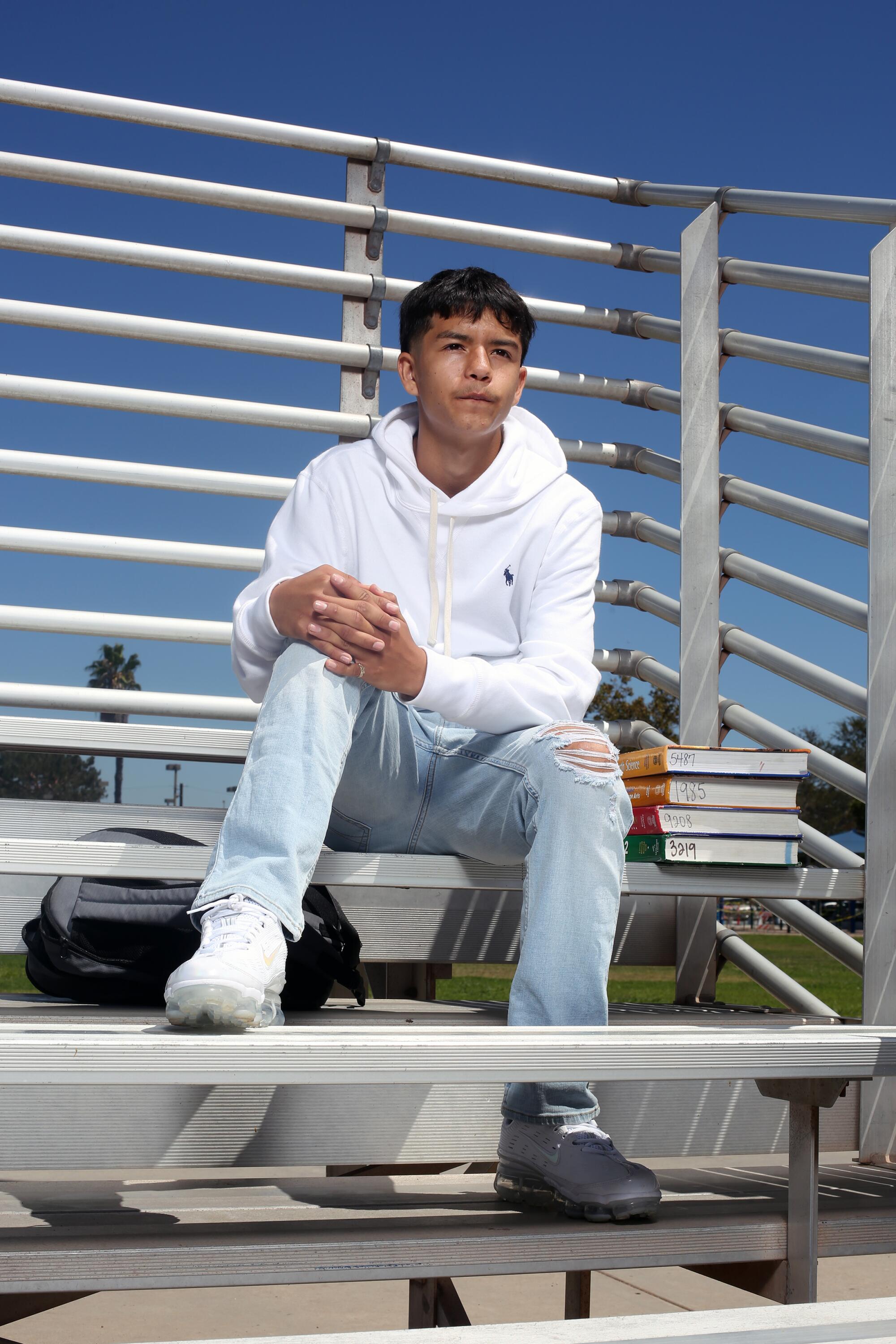
In late April on a 90-degree day, more than a month after schools closed, 10th-grader Andrew Diaz walked a mile to Lynwood High School in Lynwood to pick up a computer.
Before the shutdown, he earned As, Bs and Cs. But with schools closed, Andrew said he was struggling to feel motivated and understand his work. His mother, a single parent and healthcare worker who has cared for coronavirus patients, was working double shifts, keeping her away from home and close supervision of Andrew’s studies. For more than a month, Andrew accessed classes on his cellphone, but was too depressed and unmotivated to do so often. By the end of April, he said, he had probably turned in one complete assignment.
“I feel like when I move on to 11th grade, I’m gonna be behind, and everybody’s gonna, like, be smarter than me, and I’m afraid,” he said.
The Times survey shows that low-income-serving districts, like Lynwood Unified, were at a deep digital deficit when compared to districts serving more affluent areas. On average, about half the students in low-income-serving districts had computers available for school work when campuses closed. Among the largest districts, an average of nearly two-thirds of students had them.
But among the most affluent-serving districts, an average 87% of students had computers when campuses closed, and virtually every student — 98% — had them about three weeks later.
The difference wasn’t just that students in more affluent-serving districts had computers at home, but that several of these districts were able to give their students computers to take home on the day schools closed or in the week after, allowing each child to quickly transition to distance learning.
Many low-income-serving districts moved swiftly to buy and distribute computers and hot spots. But the process took time and in some cases was not complete before the end of the school year.
According to the survey, three weeks after campuses closed, nearly 30% of students in districts serving communities with the lowest incomes lacked devices. Six weeks later, about 12% lacked them.
At El Segundo Unified, where about half of students are white and 15% qualify for free or reduced-price lunches, Supt. Melissa Moore said the district had more than enough computers for every student who needed one when campuses closed. Only about 25 families needed help connecting to the internet, translating to as smooth a transition as possible, she said.
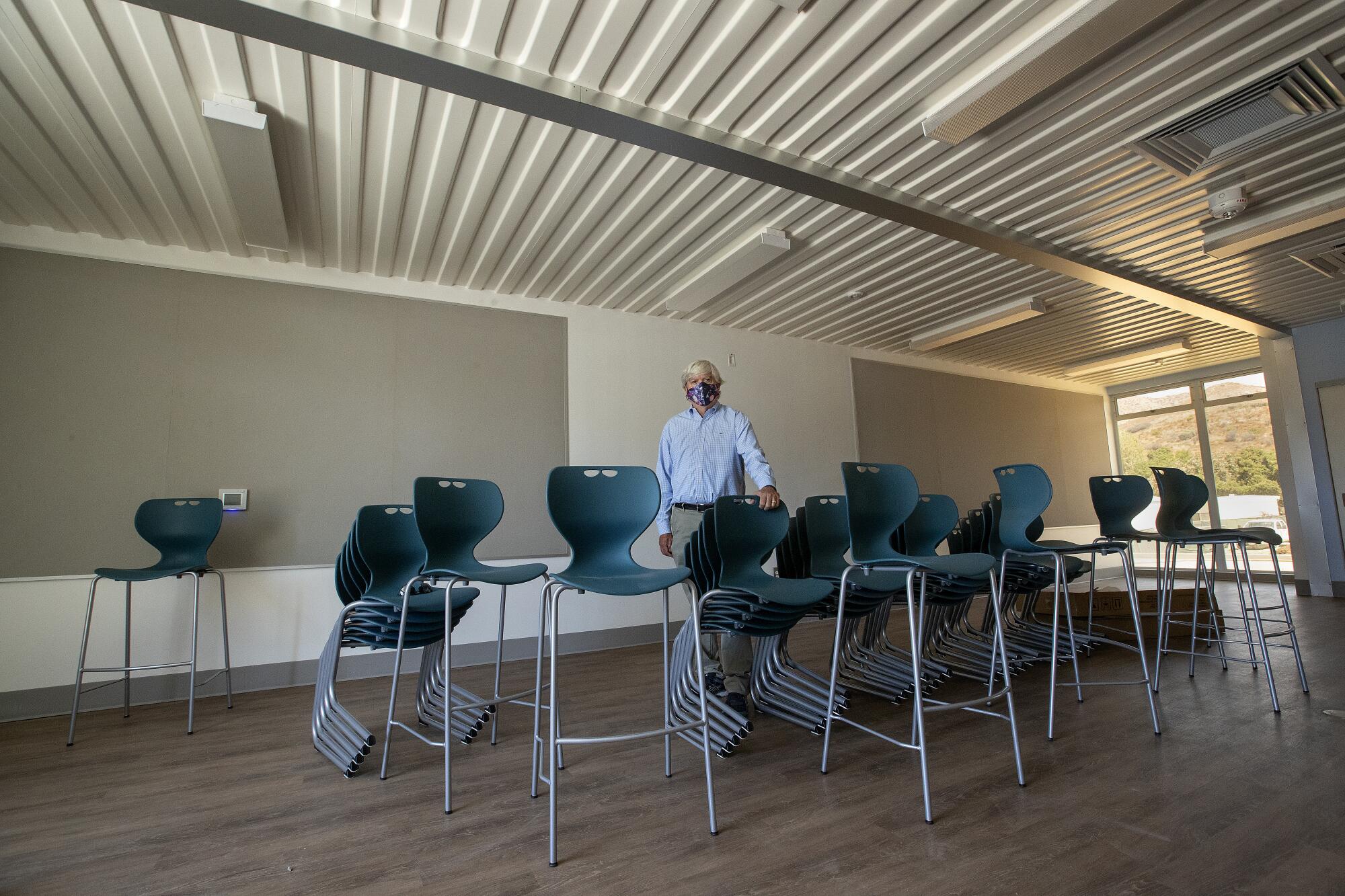
Similarly, at Oak Park Unified, a district of 4,500 students in Ventura County where 7% of students come from low-income families and more than half are white, every child already had a district-issued device, which helped schools quickly pivot to a virtual setting, said Supt. Tony Knight.
“Given we’re in the middle of a global pandemic of epic proportions,” Knight said, “we’re in good shape.”
But many districts in low-income communities struggled to bridge the digital divide, including some that had already been working to close the gap. One factor was the stampede of districts buying computers.
A first-of-its-kind LAUSD analysis of distance learning shows deep disparities in online learning.
In Lynwood, officials had ordered computers for nearly every one of its 13,000 students by November. But the computers failed to arrive on schedule, leaving students like Andrew without one for about six weeks, when the district began widespread distribution.
“We kept hearing from our vendors: ‘They should be there next week, next week,’” said Supt. Gudiel Crosthwaite.
And computers accounted for only half the equation. Lynwood had no resources to provide internet access. The county’s education office promised 100 internet hot spots, which would have helped, but the county could not find them for sale. So the school system worked with the city to provide WiFi access at a few city-owned locations as a stopgap.
In Lynwood, 9 in 10 students come from low-income families, 94% are Latino and 5% are Black.
Officials at San Bernardino Unified, one of the largest in the state, with nearly 90% low-income students, also worked to distribute computers and hot spots long before the shut-down, helping thousands of students stay connected when campuses closed, said interim Supt. Harold Vollkommer.
But even in late May, thousands more still needed hot spots, which were back-ordered, he said.
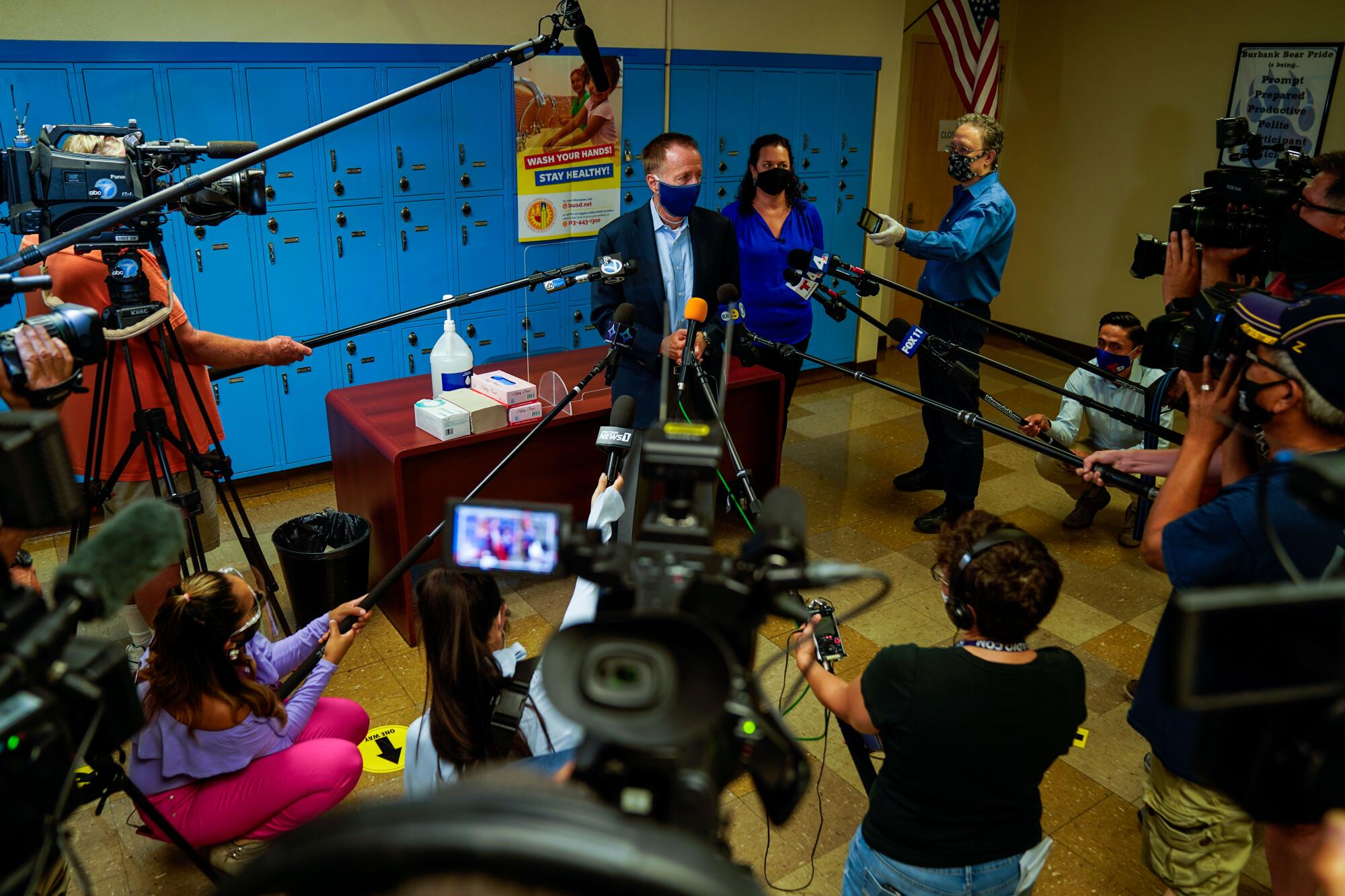
L.A. schools Supt. Austin Beutner said the nation’s second-largest school system all but commandeered the local supply chain by spending $100 million, mostly from school construction bonds, to purchase hot spots and about 200,000 computers needed for 482,000 students in kindergarten through 12th grade.
As a result, he said, local vendors cleared out warehouses and even grabbed display models from stores.
This scramble may have contributed to problems other districts experienced in purchasing technology. Even so, about a quarter of L.A. Unified students still needed computers for schoolwork in late April and some district families struggled without hot spots for well over a month.
Entering into the fall, Beutner said, no L.A. Unified student should be shut out from distance learning. The district, he said, has enough technology in stock for all students.
At Coachella Valley Unified, where almost all students are Latino, half of nearly 18,000 students had a computer at home when schools closed.
“They went home with nothing. Not one device was sent home, and no connectivity,” said Carissa Carrera, president of the Coachella Valley Teachers Assn.
The district had some older-model computers in classrooms but could not send them home because of software issues. Widespread distribution did not start until the end of April. In a desperate and resourceful move to help, the district deployed buses with WiFi routers to provide internet access during the school day. But they reached only a fraction of students.
Coachella Valley was one of the last districts in The Times’ survey to start online learning, beginning on May 1, five weeks before the end of the school year. But many lower-income-serving districts were unable to start online learning as quickly as those in more affluent areas. The median start date in districts with more affluent families was March 18. For districts with the highest numbers of low-income families and for the largest districts it was April 6.
Here’s how to get help with technology, including computers, WiFi and free meals, from your school district.
ENGAGEMENT AND LEARNING

The herculean effort to distribute technology and start online classes is only part of the battle. Once students are connected, teachers must get them to participate and learn.
Luis Chaidez, a social studies teacher at Augustus Hawkins High School in South L.A., had 120 students when schools closed. He never had more than 15 attend online classes.
“That’s the most. After that it dropped below 10,” he said. “In the last three weeks of school, I just stopped doing Zoom. Because no one was doing the work.”
He doesn’t blame them.
“People are worried about dying, and in addition to that people are being laid off, and now students in my community, where I serve, are worried about eating or rent,” he said.
He is agonizing about the ongoing campus closures.
“I’m afraid that it’s going to be another cycle that gets repeated, where students are just going to do the bare minimum of passing their classes and getting a diploma because they don’t have the luxury of leaning on a parent at home that is college-educated, who can help them,” he said.
California’s rules requiring schools to track student attendance and assess learning essentially lapsed during the spring, when the state waived them. Few districts monitored students’ time online or took roll, and almost all changed their grading policies to protect students from falling grades.
This makes it difficult to say exactly how many students were engaging with online learning. Of the 45 districts surveyed, only about 20% provided figures tracking student attendance and online engagement.
Among the districts that did report engagement to The Times, those serving more prosperous areas were more likely to report significantly higher participation.
For example, in Las Virgenes Unified, officials said 94% of middle school students logged in at least three times a week in early April.
In the Hermosa Beach City School District, where a small percentage of students are low income and about two-thirds are white, district officials said that about 95% of students were logging in three times or more per week.
“Honestly,” said Supt. Patricia Escalante, who recently retired, “I was shocked and stunned at how fantastic it went.”
In the higher poverty districts of Lynwood and Palm Springs Unified, the percentages of middle school students logging in three times or more per week were 23% and 50%, respectively, several weeks after schools closed, according to district estimates. And in Palmdale, a lower-income, majority Latino district that serves students in grades K-8, officials did not say how many students were logging in three times or more per week, but said by early April, about 60% of middle school students logged in to their online platforms per day.
Los Angeles Unified, meanwhile, reported that 78% of middle school students logged in three times or more per week several weeks after schools closed.
L.A. Board of Education approves agreement with union for structured online teaching. Critics say it needlessly shortens the traditional school day.
The picture of disparate student engagement is not black and white. With so many districts not tracking or choosing not to report engagement, it’s possible many districts with higher-income families also lagged in student engagement.
And the lower-income-serving district of South Whittier also reported higher levels of engagement. In early April, district officials said, about 88% of middle school students logged in three times or more per week. Teachers in the district took attendance every day and input the information into a Google spreadsheet accessible to school staff, who worked to track down absent students. If they were unable to find them, they passed names to the Sheriff’s Department to conduct welfare checks, officials said.
Other evidence also points to disparities in learning for students of color and those from low-income families during school closures. A preliminary report based on surveys of hundreds of districts across the country by American Institutes for Research found that students in high-poverty districts were expected to spend less time per day on instructional activities, more likely to use paper packets and more likely to focus on reviewing content than students in low-poverty districts.
And a report last month by Los Angeles Unified analysts showed deep disparities along lines of race, ethnicity and family income. While nearly every category of students included large numbers who did not regularly participate in distance learning, students from low-income families and Black and Latino students participated at rates between 10 and 20 percentage points lower than peers from higher-income families and white and Asian students.
Like Chaidez, many educators said their students are in crisis.
In Palmdale, among other districts, officials noted that many parents are essential workers who were forced to leave the schooling-at-home project to grandparents, who were typically non-English speakers without experience on computers. And Supt. Crosthwaite of Lynwood said parents in his community were overwhelmed with worries far greater than school.
“They’re worried about how they’re going to put food on the table. How are they going to pay for rent?” Crosthwaite said. “So on top of everything else ... they are trying to transition to becoming a teacher at home.”
Crosthwaite, whose district has received national recognition for enrolling students of color into advanced coursework, said he realized the depth of the problem when he agreed to be a guest speaker for two combined sections of a high school economics class. Only about half the students showed up.
Remote learning is a challenge for parents who have to leave home for work. Here’s a guide to some of the options
THE FUTURE
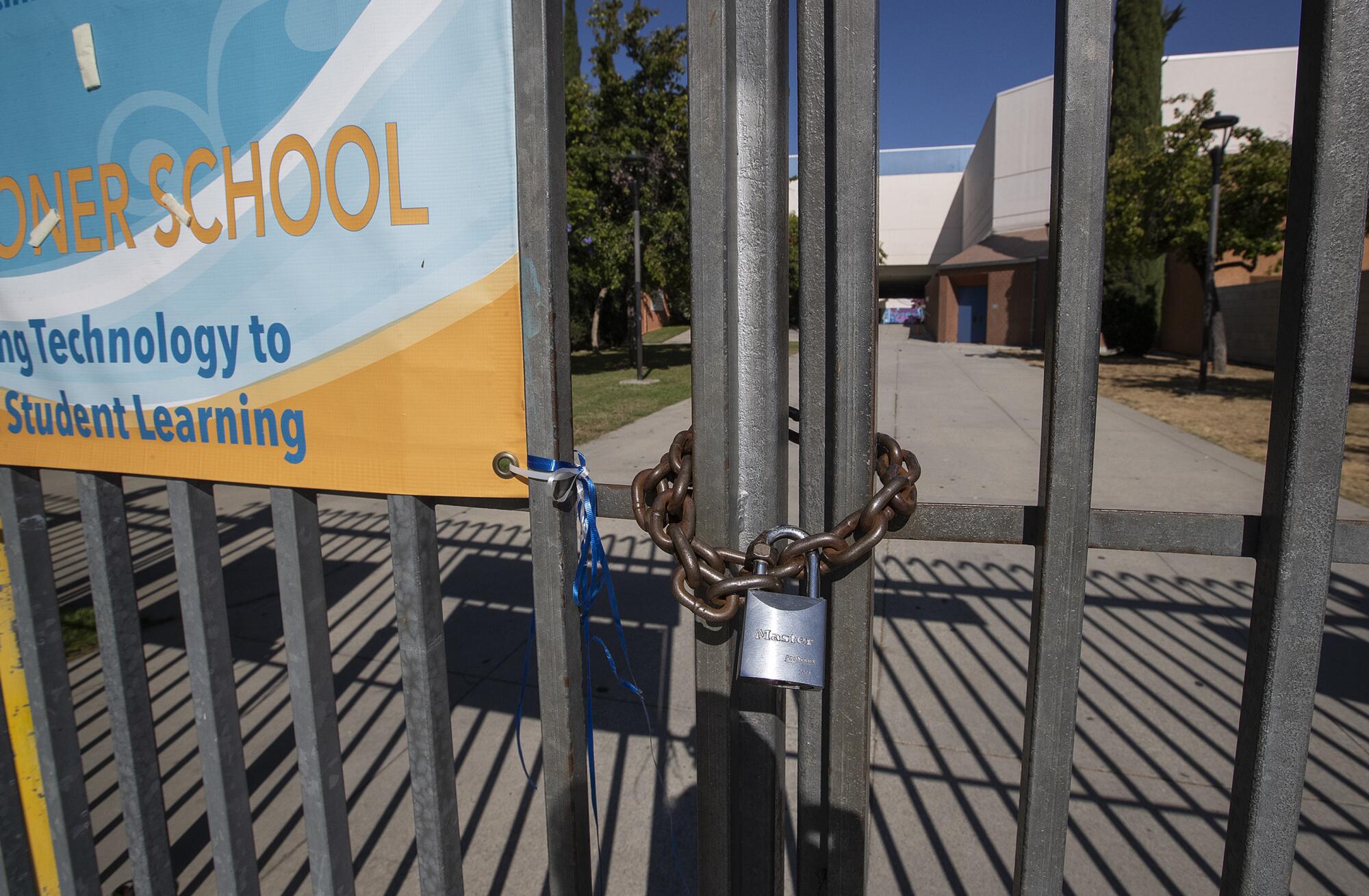
As the new school year begins, districts face a different but no less challenging landscape, with many parents increasingly fearful about the long-term consequences of prolonged closures on their children, and many educators feeling urgent pressure to help students who have been left behind.
Although more computers are in the hands of students, more than 700,000 K-12 students in California are still without them, and more than 300,000 are in need of internet hot spots. Some families are losing internet access because of expiring discounts — even as their need for broadband intensifies with children online for more hours a day.
Reactions ranged from relief to disbelief from some LAUSD parents after the district and United Teachers Los Angeles struck a deal Monday for online learning.
State officials have enacted new rules requiring teachers to take attendance, provide consistent online classes and document student learning to strengthen distance learning.
But districts must implement these new accountability systems while also planning for an eventual safe return to campus and without clarity about the duration of the health crisis.
Meanwhile, families with resources are finding ways to get their children back on track, forming multi-family learning pods and hiring tutors, while financially struggling families are desperate for child care and more learning assistance for their children.
And the hardships faced by many low-income families have only worsened in the last five months, with Latino and Black working-class communities uniquely devastated by the coronavirus.
“What COVID-19 has done, it has pulled back the covers on the gross inequities that exist in our society,”said UCLA education professor Tyrone Howard at a recent panel on school reopening. “While they’re not new ... I think in this really difficult moment, it has made the realities around inequities, even more front and center in all of our everyday lives.”
Earlier this month, Andrew Diaz made his way back to Lynwood High, this time to pick up textbooks for his junior year.
After he got his computer from the school in April, he continued struggling to stay on track with his classwork, he said. In the past, he has done well when he had good relationships with his teachers. But distance learning was different. He loves math but struggled to understand it without a teacher he could work with in person. And he couldn’t follow the Spanish work his teacher posted, which wasn’t like the Spanish he hears at home.
Eventually, he began working six days a week with his uncle, selling vegetables at a swap meet to help his mother pay bills.
He passed all of his classes — because the district, like most others, decided that no student would receive failing grades. But he knows he’s fallen behind. There were times he told his friends that he had no interest in online school. But he’d also like to go to college, like his aunt, who was the first in his family to earn a degree. And he’s planning to take the SAT this year. So as school starts again, he’s determined to turn things around.
“I’m putting my all in it. I’m going to stop helping my uncle. And then I’m gonna just try to do homework,” he said. “I just... I need to get more confident for myself.”
Times staff writers Nina Agrawal and Sonali Kohli contributed to this story.
More to Read
Sign up for Essential California
The most important California stories and recommendations in your inbox every morning.
You may occasionally receive promotional content from the Los Angeles Times.
